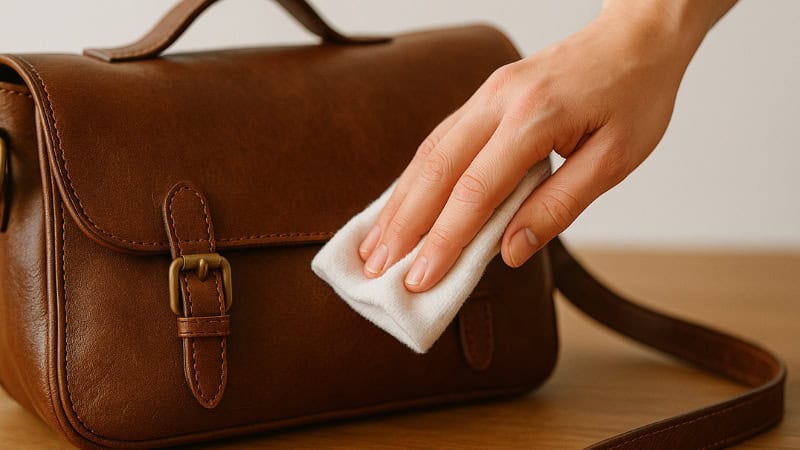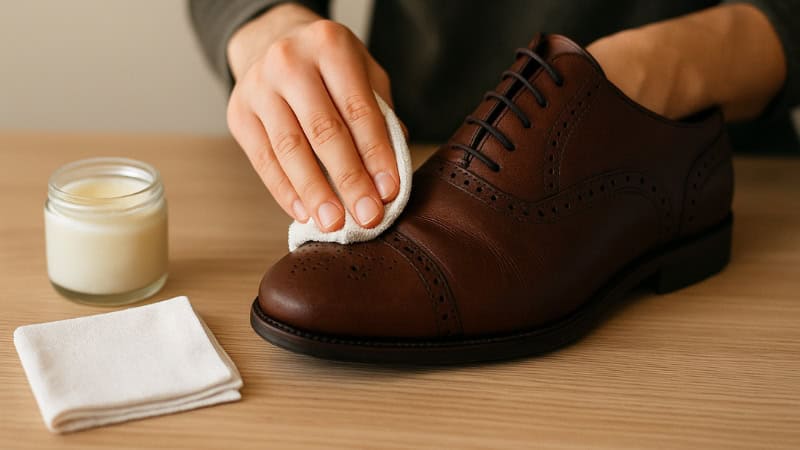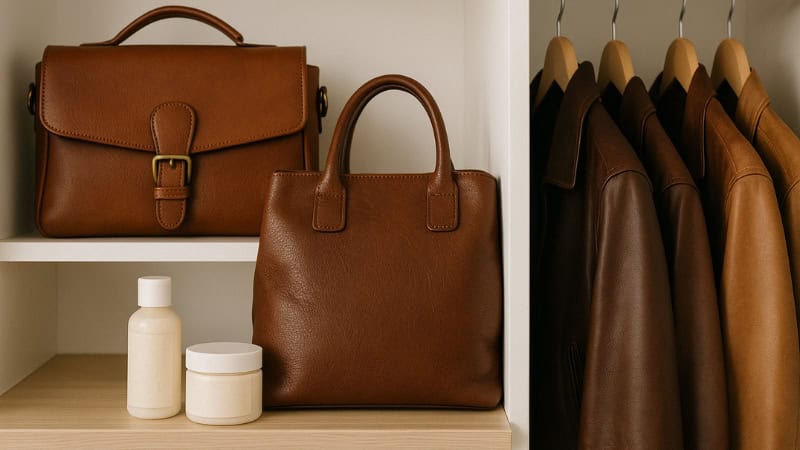Leather is known for its timeless appeal, but it can lose its softness over time. Exposure to sunlight, heat, and dry air slowly draws out the natural oils that keep it supple. Without proper care, leather becomes stiff, dull, and eventually starts to crack.
Keeping leather moisturized is essential to preserving its strength and flexibility. Just like skin, it needs regular attention to stay healthy and long-lasting. A little maintenance can go a long way in preventing damage.
In this guide, we’ll walk through simple, effective ways to bring back your leather’s natural softness through proper cleaning, conditioning, and careful storage.
Understanding Leather Care Basics
Leather may look tough, but it’s surprisingly delicate when it loses its natural moisture. Over time, oils evaporate, leaving the surface dry and brittle. The first step in learning how to moisten leather is understanding what causes that dryness — things like direct sunlight, heat from radiators, or even improper cleaning products.
It’s also important to know the difference between cleaning and conditioning. Cleaning removes dirt and grime, while conditioning restores the oils that keep the leather flexible.
Different types of leather react differently to moisture — for instance, suede demands gentle care, while full-grain leather can handle richer conditioning.
Preparing the Leather
Before diving into moistening leather, preparation is key. A well-prepped surface allows the conditioner to penetrate evenly and deeply, giving better results.
Start with a gentle cleaning:
- Use a soft, damp cloth to wipe away surface dirt and dust.
- For heavier buildup, a mild soap or leather cleaner can help—but always test it on a small spot first.
Once clean, let the leather dry naturally. Avoid hair dryers, radiators, or direct sunlight; heat will only worsen dryness.
Next, inspect for damage. Small cracks or discolorations are normal, but if you find deep cracks, go slow—those areas need extra care and lighter conditioning. Taking a few minutes for these steps ensures your leather is ready to fully absorb moisture and regain its natural softness.
Choosing the Right Moisturizing Method
Not all leather products need the same treatment — the right method depends on the type of leather and how dry it is. Here are a few reliable options to consider:
- Natural Oils
- Oils like olive, coconut, or mink oil can help restore flexibility.
- Apply sparingly — too much can darken or soften the leather excessively.
- Best for sturdy items like boots, belts, or saddles.
- Commercial Leather Conditioners
- These are specially formulated to moisturize without leaving residue.
- Look for pH-balanced products free from silicone or alcohol.
- Great for furniture, car seats, or jackets that need gentle care.
- Homemade Conditioners
- A mix of beeswax, oil, and butter can work for quick fixes.
- These should be used occasionally, as they lack preservatives and UV protection.
Choose the method that matches your item’s needs — the goal of moistening leather is to restore its softness while maintaining its natural look and durability.
Step-by-Step Moisturizing Process
Once your leather is clean and ready, it’s time to bring it back to life. The process is simple, but taking it slow makes all the difference.
- Apply a small amount of conditioner or oil.
Use a clean, soft cloth and start with just a little product. A light touch helps prevent over-saturation, which can make the leather greasy or sticky. - Work in gentle, circular motions.
Massage the conditioner evenly into the surface. Focus on dry or dull spots, as they’ll absorb more moisture. - Let it rest and absorb.
Allow the leather to sit for a few hours (or overnight) in a cool, dry place. This gives time for the oils to soak in deeply. - Wipe away any excess.
Use a fresh cloth to remove leftover residue — too much product can attract dust or clog pores. - Buff to finish.
Lightly buff the leather with a dry cloth to restore its natural sheen and smooth texture.
Following these simple steps ensures that moistening leather isn’t just about appearance — it also restores flexibility and helps extend the life of your item.
Drying and Finishing Tips
After conditioning, proper drying is just as important as the moistening itself. Leather needs time to breathe and absorb the oils you’ve applied.
Let it dry naturally.
Place the item in a cool, shaded area and allow it to air dry. Avoid heaters, hair dryers, or direct sunlight — they can draw moisture out too quickly and undo your hard work.
Add a finishing touch.
Once fully dry, give the surface a quick buff with a soft cloth. This enhances shine and smoothness. For extra protection, apply a leather protectant or waterproofing spray — especially for shoes, bags, or jackets that face regular wear.
These simple finishing steps lock in moisture, keeping your leather soft, flexible, and ready for everyday use.
Maintenance and Prevention
Keeping leather soft isn’t a one-time task — it’s an ongoing habit. A few small efforts can prevent the need for deep restoration later.
- Condition regularly.
For items used often, such as shoes or handbags, apply conditioner every 2–3 months. Furniture or jackets can usually go longer — about twice a year. - Store it properly.
Avoid leaving leather in damp basements or hot attics. Store in a cool, dry place with moderate humidity, and use dust covers when possible. - Protect from the elements.
Sunlight, rain, and heat are leather’s biggest enemies. Try to keep items out of direct sunlight and away from radiators or vents. - Watch for warning signs.
If the surface feels rough, dull, or starts to crack, it’s time for another conditioning session.
By maintaining these habits, you won’t have to wonder how to moisten leather again — your items will stay supple, rich, and beautiful for years to come.
FAQs About Moistening Leather
- How often should I moisten leather?
It depends on how frequently the item is used. Everyday items like shoes or bags may need conditioning every 2–3 months, while furniture or jackets can be treated twice a year. - Can I use olive oil to moisten leather?
Yes, but with caution. Olive oil can temporarily soften leather, though it may darken the color or cause buildup over time. It’s safer to use a dedicated leather conditioner for long-term care. If you do use olive oil, apply a tiny amount and buff thoroughly to avoid residue that attracts dust. - What’s the difference between cleaning and conditioning leather?
Cleaning removes dirt and surface oils, while conditioning restores the leather’s natural moisture and flexibility. Both steps are essential for proper upkeep. - Can water damage leather?
Yes. Water can cause stains, stiffness, or even cracking if not dried properly. If your leather gets wet, blot it gently and let it dry naturally — never use heat. To restore lost moisture afterward, follow up with a conditioner once the leather is fully dry. - How can I tell if my leather needs moisturizing?
If it feels rough, looks dull, or shows fine cracks, it’s a sign that the natural oils have evaporated. A conditioning treatment will bring back softness and shine. You might also notice the surface feels less flexible or slightly noisy when bent — both signs of dryness. - Should I use the same method for all leather types?
No. Suede and nubuck require special cleaners and sprays, while smooth leather can handle creams or oils. Always test any product on a small, hidden area first. - Can I over-condition leather?
Absolutely. Too much product can make leather greasy and weaken its structure. Always apply conditioner sparingly — less is more when it comes to moistening leather. Over-conditioning can also clog the pores of the material, preventing it from “breathing” naturally.
Wrap Up
Leather is an investment — and like anything valuable, it needs care to stay in great shape. Regular conditioning prevents dryness, cracking, and fading, keeping your favorite items soft and strong.
Moistening leather isn’t complicated; it just requires a little time and attention. With the right cleaning, a good conditioner, and careful storage, you can restore that smooth, supple texture that makes leather so appealing.
Make it part of your routine. A few minutes every few months will protect your leather for years — ensuring it looks as timeless and beautiful as the day you bought it.




